
C-C-C-Combo Breaker! I had been keeping up with weekly articles for a few months, but LEGO Marvel’s Avengers turned out to be the game that broke the streak. Basically this boils down to the fact that I only review games I’ve beaten, and I don’t necessarily beat a game every week. I’m sure my devoted reader base will be disappointed. What’s that you say? You’re telling me I don’t have a devoted reader base, and furthermore that I may be delusional? Well sir or madam, I can assure you this blog regularly receives comments featuring sketchy links to Korean, Czech and other websites on an almost weekly basis. In addition to providing dubious URLs in ample supply, these commenters often vaguely praise the blog for its ‘informative content’ and/or ‘excellent site layout’, so I can only assume they’re dedicated fans. 100% low-effort spambots to be sure, but fanbots all the same. So I’m quite certain my legion of fanbots will be excited to see this review of LEGO Marvel’s Avengers going up. Get ready for some ‘informative content’ and ‘excellent layout’.
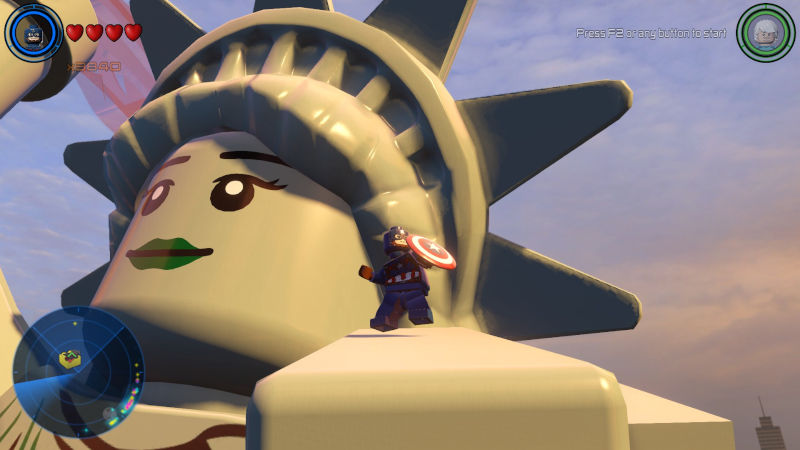
My most recent LEGO game review was back in 2023, wherein I defended the Traveler’s Tales LEGO series against (somewhat valid) criticisms that these are children’s games lacking in any sort of challenge. Playing through LEGO Marvel’s Avengers (henceforth simply ‘LEGO Avengers’), I’m afraid those criticisms cast a long shadow over the proceedings. Using the ‘children’s game’ descriptor in a negative connotation is unfair though. Really what we’re talking about here is just the notion of casual gameplay. The appropriate level of challenge for a casual game can be debated of course, but as it applies to LEGO Avengers, we’re talking about a pretty easy game. And as always, I don’t mean that as criticism. Easy-breezy, casual games absolutely have their place. Among other things, Traveler’s Tales LEGO games were some of my kids’ first introductions to gaming, and I have wonderful memories of co-op sessions from when they were just tikes (now surly teens). But playing LEGO Avengers solo as an over-the-hill old fogey, I’m coming to the realization that between the low challenge factor and the repetitive gameplay involved … I don’t enjoy these games as much as I used to. And yet, I’m not quite ready to give up on them entirely. Call it warm-fuzzy nostalgia if you like, but the good elements of these games remain steadfast, and LEGO Avengers exemplifies those elements pretty well. Let’s talk about why that is.
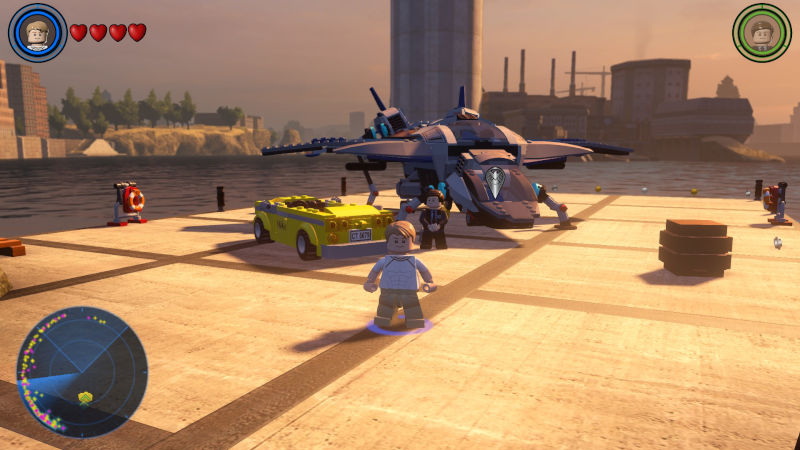
LEGO Avengers is the LEGO Marvel series ode to the Marvel Cinematic Universe. While (the unimaginatively titled) LEGO Marvel Superheroes contained elements referencing the MCU, largely in terms of interspersed environments and character design, it told a self-contained story which drew inspiration directly from Marvel comics much more so than from the Marvel film canon. LEGO Avengers is the opposite. The principal story-driven levels here are based directly upon films from Phase 1 and Phase 2 of the MCU, specifically: The Avengers, Captain America: The First Avenger, Avengers: Age of Ultron, Iron Man 3, Thor: The Dark World, and Captain America: The Winter Soldier. The good news is that these films really represent a sweet spot in the MCU, with nary a sucker in the bunch (though if one were to point to Thor: The Dark World as being the weak link in that group, I wouldn’t fully disagree). The bad news (as such) is that you’re playing note-for-note through an abridged version of the films, nothing more nothing less. If you’ve seen the films, you already know the major story beats, the characters that will appear in each given level and so forth. Traveller’s Tales has done an admirable job recreating the cinematic set pieces in LEGO form, and the choices made in terms of playable segments are shrewd, but … there aren’t a lot of surprises to be had, or unexpected moments of humor and creativity. The trouble is that in many ways these moments of serendipitous levity are pretty foundational to the Traveller’s Tales approach. In the pursuit of accuracy to its cinematic inspirations, LEGO Avengers doesn’t feature nearly as many of these moments. Even many of the jokes are drawn, literally word for word, from the films. So in terms of diligently depicting the events of each representative film in LEGO form, LEGO Avengers can be considered a win. But with regards to common tonal elements found in most other TT LEGO games, LEGO Avengers misses the mark just a bit.
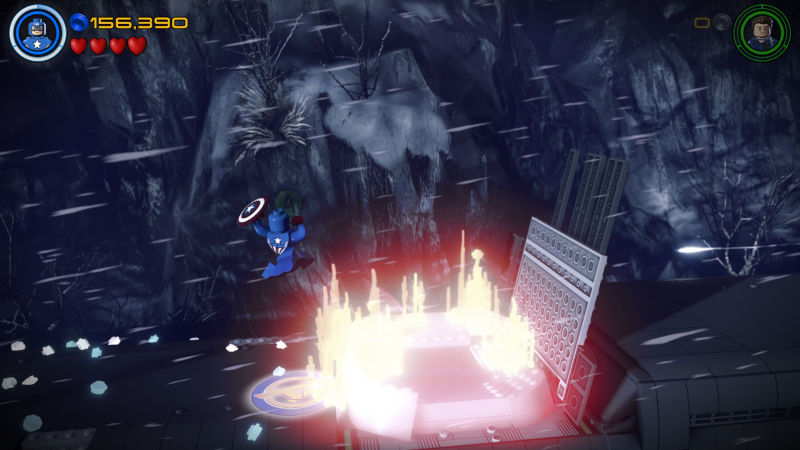
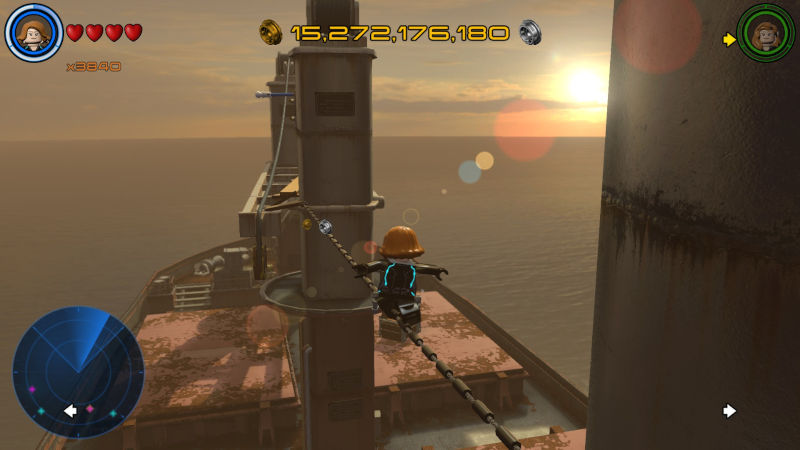
Therein lies the crux through. One of the defining strengths of TT’s LEGO games is their deft handling of fan service – most notably through their incredibly deep rosters of unlockable characters, which often include even the most obscure characters from the featured franchise. In the case of LEGO Marvel Avengers there are over 240 character slots in total, which doesn’t even include character variations (of which Iron Man alone has over 9) or DLC characters. So we’re really looking at a deep dive into all corners of Avengers lore, including characters that have never appeared in the MCU. Obviously, all the principal MCU Avengers are present and accounted for, each with multiple variations reflecting their evolving appearances throughout the cinematic franchise. We also see some extremely niche characters drawn from the films. Remember Beth the Waitress from the first Avengers movie? You couldn’t really be blamed if you missed her as she only has an exceedingly brief snippet of dialogue in the final cut of the film and is merely credited as ‘The Waitress’ in the credits (it’s her name tag that says Beth). At any rate, she’s a playable character in LEGO Avengers. There are also several characters appearing in the game who had never appeared in the MCU at all (at the time of release), ranging from fan favorites like Squirrel Girl and Wendigo, to the truly obscure like Fin Fang Foom and Finesse. Lou Ferrigno’s version of the Hulk is even tucked away as an unlockable character, and the animation for his Hulk transformation is priceless (no spoilers). It’s a deeply impressive roster and if you’re a fan of Avengers lore, be it cinematic or print, chances are your favorite character is represented here (sorry X-Men fans, we’re dealing primarily with the wild, woolly world of The Avengers here).
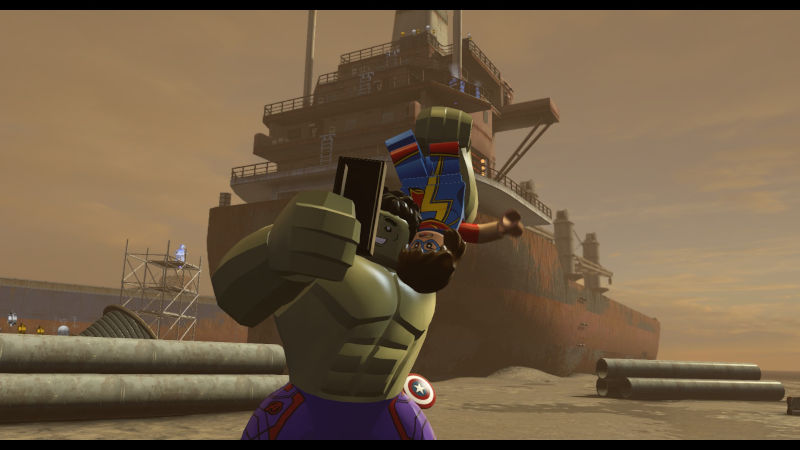
The number of powers and abilities available to all these characters is far more limited in scope though. So while you have literally 100’s of unlockable characters, they all possess some combination of (roughly) 9 ability types. This means that nearly all characters are functionally interchangeable with other similar characters. This is fairly typical of TT LEGO games, but once you have at least one character with each ‘core’ power, it starts to devolve into ‘rote collect-a-thon’ territory as you amass more and more characters that are (essentially) functional copies of one another (though admittedly it’s always fun to unlock one of your favorites). It’s actually this ‘collect all the stuff’ mentality that has come to typify the series as a whole. So once again in LEGO Avengers we find ourselves tasked with collecting all of the following: Character Tokens, Vehicle Tokens, Red Bricks, Gold Bricks, Mini-Kits, Stan Lee Rescues, and enough studs to trigger ‘True Avenger’ status in every level. I hate to say it, but it often feels like the entire focus of LEGO Avengers is built around these collectables, with all other gaming elements pushed to the side as incidental adornments to this core concept. It’s not that the levels and hubs aren’t fun to explore; they are. But it also feels like any advancement in the game is accomplished by means of driving up your completion percentage rather than completing the levels themselves. It’s like the levels only exist to serve this greater goal of reaching 100% completion, rather than the completion percentage existing as a byproduct of great level design and gameplay (if that makes any sense).
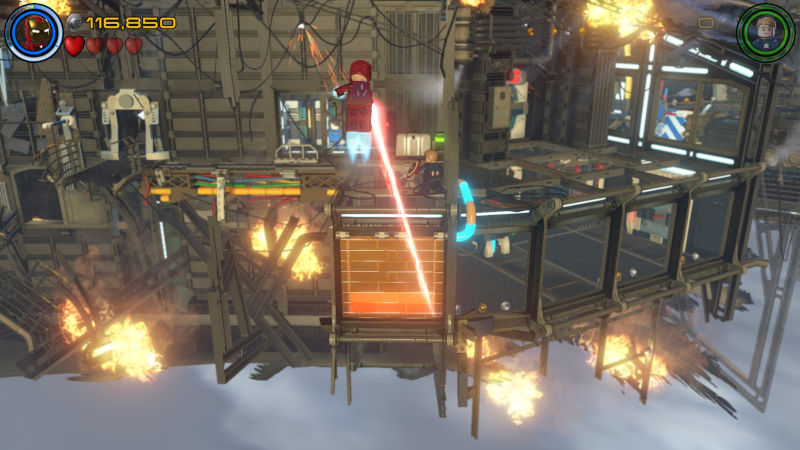
So how does LEGO Avengers rank in terms of said level design and gameplay? Well, everything will feel pretty familiar to veterans of LEGO games. In much the same way that Traveler’s Tales stuck to their formula in terms of collectibles, the gameplay here remains unchanged for the most part. So what we’re looking at is (once again) a leisurely paced free-roaming beat’em up interspersed with regularly repeating puzzle elements. The puzzles formats are not only repeated within the game (as one might expect) but most of them are also holdovers from earlier LEGO games. On one hand, common points of reference are what defines a series. On the other hand, after so many LEGO games featuring the exact same puzzle types, it would have been nice to see them shake things up a bit. Alas, LEGO Avengers doesn’t rock the boat in terms of new and creative puzzles.
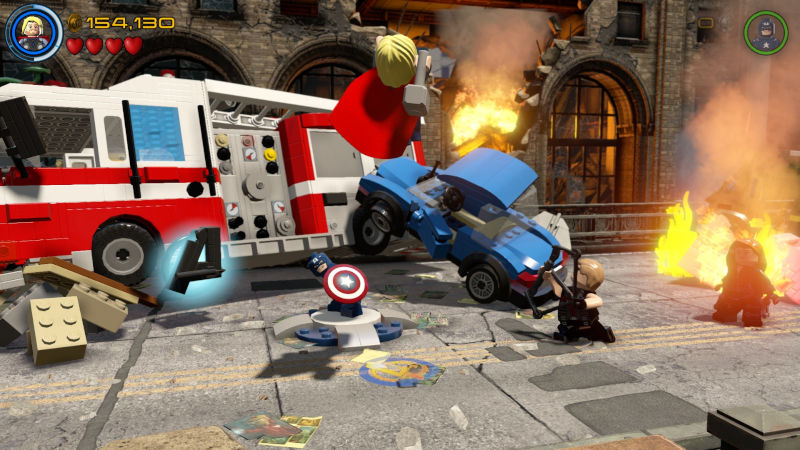
That said, the combat in LEGO Avengers has been tweaked, if only ever so slightly. Essentially they’ve introduced a very simple system of chaining combos. If you can maintain a combo of attacks going after you’ve defeated a single opponent, your stud multiplier will be raised by a factor of one for each additional opponent you defeat in the combo. This is actually a refreshing development not seen in previous LEGO games, and it does make it slightly easier to achieve that elusive “True Avenger” status. Combat also now features combo attacks with your partner. Although I was never quite able to determine the conditions that enable them, these special tandem attacks defeat several opponents at once. The nature and animation of the combo attack is dependent upon what characters you’re using at the time. For instance if you’re playing as Thor and Captain America, Thor leaps into the air and brings Mjolnir down on Cap’s shield sending out a deadly shockwave. These combo attacks are a neat touch, and are certainly effective in combat. Perhaps less thrilling is the introduction of one-hit kills. On the surface this seems like a great idea. Frequently in combat, you’ll see that you can execute a one hit kill against an opponent with a single button press. The trouble is that, almost without fail, the canned animations for one-hit kills take roughly three seconds (accompanied by some kind of ‘cool one-liner’), during which time you have no control of your character. Three seconds may not sound like a lot, but between the fact that the animations quickly start repeating themselves (along with those corny one-liners), and the way they break the rhythm of combat … they kind of start to feel like tedium fairly quickly.
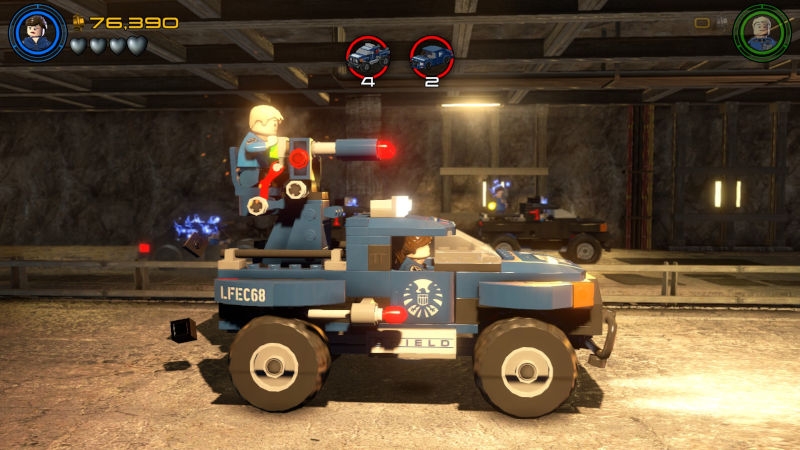

Mechanically … LEGO Avengers fairs about average for the TT LEGO series. As we delve into a discussion of the mechanics, I do need to point out an Achilles heel of the TT LEGO series; one that’s fairly egregious in LEGO Avengers. For whatever reason, these games have never worked out an efficient system of menus and loading screens. Upon firing up the game, by my count, you navigate and wait through a combination of eleven loading screens, menus and confirmations. It’s absolutely comical. Loading between various elements in-game can also cause some slight interruptions, but nothing comes close to simply starting the game. Once you’ve started playing though? Just as in previous LEGO games it’s entirely likely you’ll encounter a couple of glitches and bugs here and there. I encountered at least two freeze-ups during my playthrough which required restarting the game. The camera system has always been ‘quirky’ in LEGO games, and it’s no different here. Occasionally it has trouble focusing on what it should, particularly when you’re selecting ranged targets to fire upon. I was actually ready to absolutely shred the camera system, as it would suddenly and continually start to drift here and there, requiring that I make continual stick adjustments just to hold it in one place for any length of time. Near the end of the game I realized that the right thumb stick on my controller had developed a rather severe case of stick drift, which is what was causing the camera drift (go figure). So while I’m still going to say that LEGO Avengers has a janky camera system, you may need to take my criticism with a grain of salt. All told in terms of mechanics, what we see here is “typical LEGO game jank”, and it’s unfortunate that as of LEGO Avengers, Traveler’s Tales was still struggling with this kind of thing.
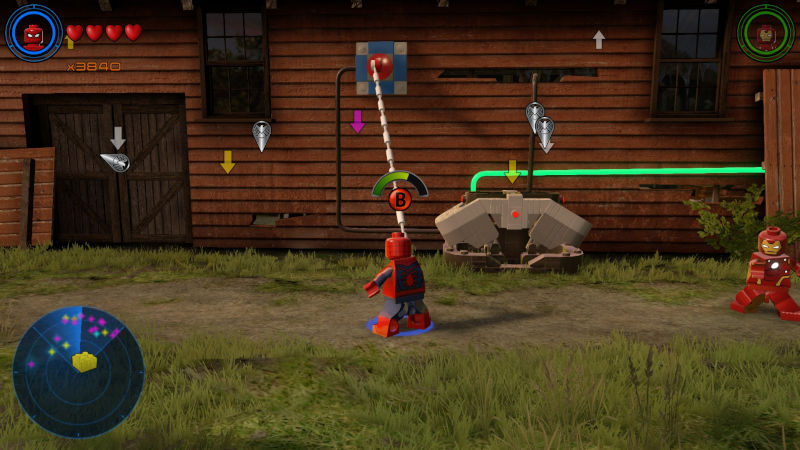
Let’s delve into presentation elements before we snap the final pieces of this review into place. Graphically LEGO Avengers is a joy to behold. Traveller’s Tales has consistently upped the ante in terms of visual elements in these games, and at the time of its release, LEGO Avengers was likely the pinnacle of the series thus far. Characters are all well animated and have an appropriate level of detail for a game of this type. It’s deeply impressive that you can look at a simple in-game minifig and clearly recognize the features of Robert Downey Jr. Likewise each individual locale is alive with recognizable details from the MCU films. LEGO Marvel Super Heroes gave us a satisfying version of LEGO Manhattan, and that carries forward here along with a handful of other fun locations (Washington D.C., Malibu, the ubiquitous S.H.I.E.L.D. Helicarrier, etc.). So in the graphics department, LEGO Avengers really succeeds with aplomb. Sound design … is a bit hit-or-miss unfortunately. Some characters received new in-game voicework recorded by the principal actors. And in those cases, the voicework is fantastic. As ‘the cool Grandpa of a generation’ It’s always a joy to hear Stan Lee’s voice in absolutely anything. R.I.P. Stan the Man; we miss you dearly! For other characters though, the voice work is stitched together from snippets of speech lifted from the movies. And that’s fine … I guess … but the trouble is that these snippets weren’t mixed into the game particularly well in terms of volume level, ambient noise, echo, you name it. It’s like they literally held a mic up to a TV, recorded snippets of dialogue, and then plugged those directly into the game without any additional mixing whatsoever. Iron-Man, Thor, Bruce Banner, Black Widow, Captain America, and others are all effected by this issue. And look, I understand; it probably wasn’t in the budget to have Scarlett Johansson come down to the studio and record voicework for a LEGO game, but … I think even using reasonable sound-alikes might have been preferable to using these poorly mixed snippets. That being said, The Avengers theme is certainly a rousing composition and the in-game version here is pretty great. So at least in terms of music and score, LEGO Avengers can be considered a win.
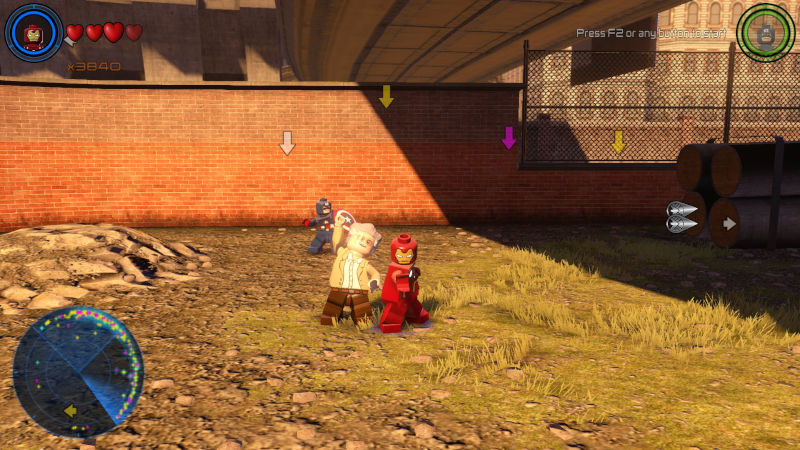
I feel like this review has placed more emphasis on LEGO Avenger’s flaws than on its strengths. And if I’m being honest, part of that can simply be chalked up to series fatigue on my part. I’ve played quite a number of these games at this point, so of course I’m going to be acutely aware of long running series foibles that have persisted from one title to the next over the years. If you’re coming to this series as a new player looking for a fun and expansive casual-game (with a heavy focus on collectible elements), you’re going to have a great time. Likewise, if you’re a gaming parent looking for a fantastic co-op experience to share with your younglings, I can personally attest that LEGO Avengers is brilliant (especially if those young ones dig Marvel superheroes). In either of those scenarios you can probably add at least a full point to my final review score. But as a single player experience for anyone who’s played previous LEGO games … Marvel’s LEGO Avengers is simply more of the same, nothing more, nothing less. ‘Nuff said, true believers.
Final Verdict: 7 Stan Lees out of 10 Rescues.
Leave a Reply